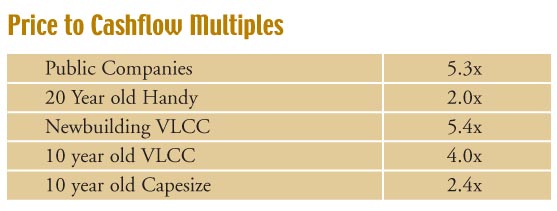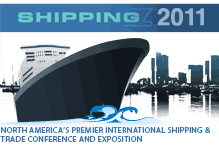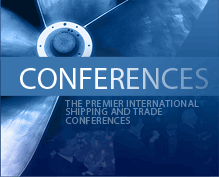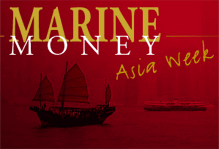When Listing Companies Have Accidents
It has been an unusually active month for incidents involving vessels owned by shipping companies that are public, related to public companies and planning to go public.
First came the Athos I, a panamax tanker that on November 26th, the Friday after Thanksgiving, struck a submerged object punching two holes in the cargo and ballast tank ultimately releasing a still unknown quantity of crude oil as it was being maneuvered to a dock at the Citgo terminal on the Delaware River in Philadelphia. The incident has already exceeded the $45 million of $1200 per grt liability limit under OPA and many claims have not yet been filed. The ship’s manager was Tsakos Shipping and Trading, a private company controlled by the Tsakos family but completely separate from NYSE-listed TEN.
Next, on December 2nd, a 1998-built panamax bulker named Selendang Ayu lost power while in transit from Tacoma to China with a cargo of soybeans and ended up breaking up on the rocks on the west coast of Unalaska Island. The Coast Guard rescue effort resulted in the loss of six seafarers’ lives. The bow has now sunk while the stern remains aground and salvors are still working to remove diesel and bunkers from the stern. There are confirmed reports that about 40,000 gallons of oil have been lost, though the vessel had about 424,000 gallons on board.
The Selendang Ayu is part of the 14-vessel bulker fleet owned by Global Maritime Ventures (GMV), a joint venture between the Malaysian Government and the Tsao family’s IMC, which has a minority interest and serves as the vessel’s commercial manager. GMV, like Malaysian Bulk Carriers, is a joint venture created through Malaysian Development Bank, Bank Industri & Teknologi Malaysia, and the private sector in an effort to boost the country’s international maritime industry. MBC, which was a joint venture between the Kuok family and the Malaysian Government, went public in 2004.
IMC is planning a massive $400 million equity offering on the Singapore Stock Exchange during the first half of 2005 through lead underwriter Goldman Sachs and BNP Paribas. IMC was previously listed in Hong Kong (primary) and Singapore (secondary) but took the company private in 2002 when investor interest in bulk shipping companies was anemic.
Finally, this week, the 1992 built, 96,000dwt doubled hulled aframax Tsunami, owned by George Economou, collided with a terminal pier on the Mississippi River. The incident has resulted in the spillage of a minor amount of caustic soda but fortunately the three-foot puncture in the vessel did not pierce the inner hull containing the nearly 90,000 tons of cargo and bunkers on board. The Tsunami is not part of the fleet of ships that is being offered to the public beginning next week in an IPO lead underwritten by investment bank Cantor Fitzgerald, but Economou’s connection to the ship is well known.
It has been an unusually active month for incidents involving vessels owned by shipping companies that are public, related to public companies and planning to go public.
First came the Athos I, a panamax tanker that on November 26th, the Friday after Thanksgiving, struck a submerged object punching two holes in the cargo and ballast tank ultimately releasing a still unknown quantity of crude oil as it was being maneuvered to a dock at the Citgo terminal on the Delaware River in Philadelphia. The incident has already exceeded the $45 million of $1200 per grt liability limit under OPA and many claims have not yet been filed. The ship’s manager was Tsakos Shipping and Trading, a private company controlled by the Tsakos family but completely separate from NYSE-listed TEN.
Next, on December 2nd, a 1998-built panamax bulker named Selendang Ayu lost power while in transit from Tacoma to China with a cargo of soybeans and ended up breaking up on the rocks on the west coast of Unalaska Island. The Coast Guard rescue effort resulted in the loss of six seafarers’ lives. The bow has now sunk while the stern remains aground and salvors are still working to remove diesel and bunkers from the stern. There are confirmed reports that about 40,000 gallons of oil have been lost, though the vessel had about 424,000 gallons on board.
The Selendang Ayu is part of the 14-vessel bulker fleet owned by Global Maritime Ventures (GMV), a joint venture between the Malaysian Government and the Tsao family’s IMC, which has a minority interest and serves as the vessel’s commercial manager. GMV, like Malaysian Bulk Carriers, is a joint venture created through Malaysian Development Bank, Bank Industri & Teknologi Malaysia, and the private sector in an effort to boost the country’s international maritime industry. MBC, which was a joint venture between the Kuok family and the Malaysian Government, went public in 2004.
IMC is planning a massive $400 million equity offering on the Singapore Stock Exchange during the first half of 2005 through lead underwriter Goldman Sachs and BNP Paribas. IMC was previously listed in Hong Kong (primary) and Singapore (secondary) but took the company private in 2002 when investor interest in bulk shipping companies was anemic.
Finally, this week, the 1992 built, 96,000dwt doubled hulled aframax Tsunami, owned by George Economou, collided with a terminal pier on the Mississippi River. The incident has resulted in the spillage of a minor amount of caustic soda but fortunately the three-foot puncture in the vessel did not pierce the inner hull containing the nearly 90,000 tons of cargo and bunkers on board. The Tsunami is not part of the fleet of ships that is being offered to the public beginning next week in an IPO lead underwritten by investment bank Cantor Fitzgerald, but Economou’s connection to the ship is well known.
What Ship Accidents Mean to Shipping Investors
What do these kinds of incidents mean to investors in the public or soon to be public companies that own the vessels? The answer from capital markets professionals in New York is clear – very little. To shed light on the potential implications of taking a company public that has the contingent liability of an environmental incident not yet quantified, we asked Glen Oxton, a partner at premier New York maritime law firm Healy and Baillie, John Sinders, Managing Director of leading maritime investment bank Jefferies, and Gary Wolfe, partner at Seward & Kissel, the most active law firm doing securities work on behalf of shipowners, for their views on the subject.
Oxton, Wolfe and Sinders Share Their Views
“For all practical purposes, there really is no issue here,” Oxton said. “Standard P&I coverage for non-tank vessels is $1 billion, and unless the incident has been catastrophic, the settlements and judgments should not reach into the equity value of the listing company,” he added. “Although investors shouldn’t worry that the company will soon be driven into bankruptcy by claims, the one real potential economic repercussion is that the company’s insurance rates will rise because of the loss, but that is likely to be it.”
Gary Wolfe echoed the sentiment; “with the exception of the Exxon Valdez, there has never been an environmental incident resulting from a vessel that has exceeded the then available P&I coverage – not Sea Empress, not Amoco Cadiz, none of them. Besides which, if the company is structured properly, the liability should be contained at the subsidiary vessel owning level. That means that you might lose the vessel, but not the whole fleet in case of an oil spill catastrophe,” Wolfe said.
John Sinders agreed. “It’s really just a marketing issue. Unless an incident brings to light the advanced age of the vessel or fleet or a pattern of poor quality commercial management, it’s really not very meaningful.” When asked how he would handle an accident like the Selendang Ayu, which at worst is only 1/10th of the size of Valdez and may be much less, Sinders said he would pause, but only briefly. “I would encourage a company that plans a listing to wait to go to market until the response community has a feel for the scope of the damage. After that, the company will be judged on the manner in which it responds and this will be clear from their actions. The reality is that although it happens very rarely, ships, like airplanes, sometimes have accidents; it’s how infrequently they occur and how you deal with them that defines a company.”
Categories:
Freshly Minted,
Markets | January 6th, 2005 |
Add a Comment
CORRECTION: Why Fredriksen Doesn’t Submit Expense Reports
We must have been drinking too much Aquavit when we read Frontline’s December 13th 13-D filing outlining its purchase and sale of General Maritime shares. In an article that appeared in the December 16th issue of this publication, we said that “Frontline made a filing on Monday which stated that the Fredriksen-related Bandama sold 33% of it 2.4 million shares in General Maritime and realized a profit of $10 million with another $6 million in unrealized gains. Frontline actually financed the share purchase from working capital, but FRO shareholders did not benefit from the profit.” Below is the relevant section of the Filing on which we based on our flawed conclusion:
“Item 3. Source and Amount of Funds or Other Consideration.
Between October 27, 2004 and December 3, 2004, Bandama acquired 2,451,300 shares of Common Stock through a series of New York Stock Exchange purchases for a total consideration of approximately $100,155,369 (excluding commissions) in cash paid from Frontline’s working capital funds. Between December 6, 2004 and December 10, 2004, Bandama sold an aggregate of 826,300 shares of Common Stock on the New York Stock Exchange. Frontline, Hemen and Fredriksen do not own any shares of Common Stock.”
In fact, Bandama IS a wholly owned subsidiary of Frontline and therefore Frontline shareholders DID benefit from the trade. Our error was in confusing Hemen Holdings, which is owned by major Frontline shareholder John Fredriksen, and Bandama.
In reality, although historically transactions that benefit insiders are hardly uncommon in this business, Frontline has been extraordinarily generous to shareholders over the years. In addition to keeping SG&A the lowest in the business and dividending every spare dollar, John Fredriksen and Tor Olav Trøim only draw salaries of $150,000 and $75,000, respectively, and are the only two members of the Frontline management team that have not been granted stock options. Fredriksen doesn’t even ask the company to reimburse him for his travel and entertainment expenses. Why? Because, according to Troim, with the stock trading at a PE of 3, it would actually be dilutive to 36% shareholder Fredriksen.
We must have been drinking too much Aquavit when we read Frontline’s December 13th 13-D filing outlining its purchase and sale of General Maritime shares. In an article that appeared in the December 16th issue of this publication, we said that “Frontline made a filing on Monday which stated that the Fredriksen-related Bandama sold 33% of it 2.4 million shares in General Maritime and realized a profit of $10 million with another $6 million in unrealized gains. Frontline actually financed the share purchase from working capital, but FRO shareholders did not benefit from the profit.” Below is the relevant section of the Filing on which we based on our flawed conclusion:
“Item 3. Source and Amount of Funds or Other Consideration.
Between October 27, 2004 and December 3, 2004, Bandama acquired 2,451,300 shares of Common Stock through a series of New York Stock Exchange purchases for a total consideration of approximately $100,155,369 (excluding commissions) in cash paid from Frontline’s working capital funds. Between December 6, 2004 and December 10, 2004, Bandama sold an aggregate of 826,300 shares of Common Stock on the New York Stock Exchange. Frontline, Hemen and Fredriksen do not own any shares of Common Stock.”
In fact, Bandama IS a wholly owned subsidiary of Frontline and therefore Frontline shareholders DID benefit from the trade. Our error was in confusing Hemen Holdings, which is owned by major Frontline shareholder John Fredriksen, and Bandama.
In reality, although historically transactions that benefit insiders are hardly uncommon in this business, Frontline has been extraordinarily generous to shareholders over the years. In addition to keeping SG&A the lowest in the business and dividending every spare dollar, John Fredriksen and Tor Olav Trøim only draw salaries of $150,000 and $75,000, respectively, and are the only two members of the Frontline management team that have not been granted stock options. Fredriksen doesn’t even ask the company to reimburse him for his travel and entertainment expenses. Why? Because, according to Troim, with the stock trading at a PE of 3, it would actually be dilutive to 36% shareholder Fredriksen.
Categories:
Freshly Minted,
Markets | January 6th, 2005 |
Add a Comment
4TH ANNUAL GERMAN SHIP FINANCE FORUM – Feb. 24 – HAMBURG
We are very pleased to inform you that the program for the above ship finance forum is ready and available at our web site. To see the program, registration and accommodation please follow the link on the “welcome” page.
This year we have an impressive group of speakers who will share their views on what will happen on the deal side in 2005. As this has become the largest one-day ship finance forum in the market, we advise you to register early in order to secure your seat. For more information about the forum contact Peder Bogen at pbogen@marinemoney.com.
We are very pleased to inform you that the program for the above ship finance forum is ready and available at our web site. To see the program, registration and accommodation please follow the link on the “welcome” page.
This year we have an impressive group of speakers who will share their views on what will happen on the deal side in 2005. As this has become the largest one-day ship finance forum in the market, we advise you to register early in order to secure your seat. For more information about the forum contact Peder Bogen at pbogen@marinemoney.com.
Categories:
Freshly Minted,
Markets | January 6th, 2005 |
Add a Comment
CALL FOR NOMINATIONS – 2004 Marine Money “Deal of the Year” Awards
As we do every January, the editorial team at Marine Money, along with several outside advisors, is preparing to judge the 2004 Deal of the Year Awards – and we would appreciate your feedback. Please follow the link available on the “welcome” page and take a few moments to fill out our ANONYMOUS and CONFIDENTIAL nomination form. As a reminder, the awards are given to FINANCIAL ADVISORS, not the shipping companies themselves, and the criteria are deals that deliver superior value to the clients. No deal is too small, and no fee is too big, so don’t be shy!!
Winners will be announced in the February issue of Marine Money and, as always, the awards presentation will be held during Marine Money Week - at the Plaza Hotel in June 2005.
As we do every January, the editorial team at Marine Money, along with several outside advisors, is preparing to judge the 2004 Deal of the Year Awards – and we would appreciate your feedback. Please follow the link available on the “welcome” page and take a few moments to fill out our ANONYMOUS and CONFIDENTIAL nomination form. As a reminder, the awards are given to FINANCIAL ADVISORS, not the shipping companies themselves, and the criteria are deals that deliver superior value to the clients. No deal is too small, and no fee is too big, so don’t be shy!!
Winners will be announced in the February issue of Marine Money and, as always, the awards presentation will be held during Marine Money Week - at the Plaza Hotel in June 2005.
Categories:
Freshly Minted,
Markets | January 6th, 2005 |
Add a Comment
The Beginning of the End…?
Citigroup Smith Barney analyst John Kartsonas reports that dayrates for all classes of vessels have fallen by an average of more than 60% while Jefferies analyst Ray Wu reports that VLCC spot rates have fallen around 80% over the past eight weeks. JP Morgan analysts note that tanker stocks themselves have correspondingly fallen by 20-35%. An extrapolation of current trends would of course predict future devastation of the tanker industry, but fortunately these trends appear to be more of a temporary correction than an indicator of future rate and stock price falls.
Citigroup Smith Barney analyst John Kartsonas reports that dayrates for all classes of vessels have fallen by an average of more than 60% while Jefferies analyst Ray Wu reports that VLCC spot rates have fallen around 80% over the past eight weeks. JP Morgan analysts note that tanker stocks themselves have correspondingly fallen by 20-35%. An extrapolation of current trends would of course predict future devastation of the tanker industry, but fortunately these trends appear to be more of a temporary correction than an indicator of future rate and stock price falls.

Categories:
Freshly Minted,
Markets | January 6th, 2005 |
Add a Comment
By Mark MacLean, Morgan Stanley
We view the energy shipping stocks as expensive at current levels as overcapacity in the second half of 2005 could temper tanker rates and asset values. The stocks are currently trading at high multiples on lofty net asset values and midcycle earnings.
Near-term fundamentals remain strong. The typical seasonal trade in the tankers has been exaggerated by an estimated 1.9 million barrels per day (mbpd) year-overyear increase in crude oil demand (4Q04/4Q03), supply disruptions in the GoM to the tune of 0.4 mbpd, and the start of the International Maritime Organization’s (IMO) mandatory phased scrapping of single hull tankers on April 5, 2005. Over the next six months, we estimate that deliveries will only slightly outpace scrapping by 2.0 million dwt. Potential delays at the Turkish Straits also point to improving near-term fundamentals and higher tanker rates, barring a significant downturn in the economy and crude oil demand. Continue Reading
Categories:
Marine Money | January 1st, 2005 |
Add a Comment
By Ole-Rikard Hammer, P.F. Bassøe
2005: A wake up call or a Triple Crown for owners?
2005 is the Chinese Year of the Rooster. Other than the fact that anything to do with China continues to gain in importance for shipping, the relevant question for the tanker market is whether owners are finally due for a wake up call. This market has a poor track record of holding on to high levels, and the odds thus appear to favour a downturn. Unfortunately for those looking for an easy answer, there are plenty of good arguments in favour of another year of very strong rates. Could owners make it three in a row?
The most remarkable thing about the most remarkable tanker market in modern times was the relative absence of remarkable factors. There were no wars, strikes or unusual weather (with the notable exception of hurricane Ivan) to explain the incredible strength of rates; it was simply a classic situation of too many cargoes chasing too few vessels. While these forces certainly will become better aligned in 2005, particularly because fleet capacity is set for a considerable increase, continued strong demand growth will make a huge swing in currently very tight fundamentals difficult to achieve. Freight markets should thus be capable of delivering another year of high, but volatile, returns to owners. Rigid capacity growth introduces a new and higher level of risk, however. Continue Reading
Categories:
Marine Money | January 1st, 2005 |
Add a Comment
By Matt McCleery
During the last 12 months, the relationship between shipping and the U.S. capital markets has seen a major evolution. The strong cash flows generated by shipping assets, combined with U.S. legislation that reduces taxes on dividends to 15%, low interest rates and low volatility in the equity markets, has created a market in which ships are suddenly worth more to investors for their free cash flow generation than they are to other shipowners in the sale and purchase market.
Beginning with the creation of Ship Finance International in December 2003 and continuing with Arlington Tankers in November and soon Teekay’s Master Limited Partnership, investment banks have been developing what are essentially lightly leveraged sale/leasebacks on tonnage in which the equity is sourced from the public markets. Continue Reading
Categories:
Marine Money | January 1st, 2005 |
Add a Comment
By Randee E. Day, Managing Director, Seabury Group
The Sarbanes-Oxley Act of 2002 established new and enhanced standards for corporate accountability and penalties for corporate wrongdoing. Without question, these new requirements have placed substantial demands on companies’ executives and all of those involved in the corporate accounting and reporting process. These requirements are designed to encourage the executive management of the company and its board of directors to provide their shareholders with transparent information about the company’s financial condition, results of operations, cash flows and general aspects of business. Failure to comply or misstatements in the financial reporting process can result in stiff civil and criminal penalties. Simply stated, those involved in the reporting task: the management, board and external auditors; no longer have a choice as to whether or not they implement the required SEC procedures. The integrity of the financial information, in the final analysis, is a reflection of the integrity of the management and board of directors and will determine the level of trust that investors will have in any financial reporting and disclosure of the company.
Specific examples of procedures newly mandated by Sarbanes-Oxley reporting include the increased power of the audit committee and the requirement of an internal anonymous hotline for employees. A frequent topic of discussion at the board level is whether the costs of Sarbanes-Oxley compliance and the potential for liabilities it creates outweigh the benefits of access to the public capital markets. The reality is that Sarbanes- Oxley seeks to impose upon a corporation a culture that values internal control and corporate governance consistent with the Act’s standards. Continue Reading
Categories:
Marine Money | January 1st, 2005 |
Add a Comment
With cash building on the balance sheets and shares trading at healthy multiples of book and asset values, many public shipping companies, have been continuing their drive to consolidate their markets, broaden the profile of their fleets and diversify their sources of revenue.
The most recent, and perhaps most dramatic example of this is OSG’s momentous $1.3 billion acquisition of Stelmar in mid-December. And that’s not even the only major deal that OSG has done since Morten Arntzen joined the company as CEO a year ago. The company has purchased U.S. flag tankers, secured 25-year contracts for 2 LNG carriers and acquired a 50% interest in 4 ULCCs. However, the NYSE-listed tanker company’s recent decision to acquire Stelmar Shipping for $48/share stands out as the first time the company has actually made an aggressive bet on the markets rather than simply using its superior balance sheet to generate a return on shareholder equity.
The $1.3 billion acquisition, which is expected to close in January, is a mammoth and transformational one for OSG. It will nearly double the company’s international fleet from about 50 to about 90 tankers, establish a major foothold in the product tanker market and require an outlay of $843 million in cash and the assumption of Stelmar’s $450 million in net debt. Continue Reading
Categories:
Marine Money | January 1st, 2005 |
Add a Comment









